- History of Oriental Frills
- Shortface Standards
- Show Reports
- British Nun Club
- Breeding Nuns
- British Nun Standard
- Nun Club Results
- Nun Club History
- BPSS Exhibition News
- BPSS History
- BPSS Trophies
- BPSS Regs
- BPSS Hall of Fame
- BPSS Classification
- BPSS Entry Form
- Show Hall
- Gallery
- Fancy Pigeon Gallery
- BPSS Best In Show Winners
- Fanciers
- Housing
- Hints & Tips
- Donovon White, USA
- Ludlow
- National Peristeronic Soc
- Sale Birds
- Pointing The Way
- Show Dates
- BPSS Section Winners
- Directions
- LINKS
Fanciers
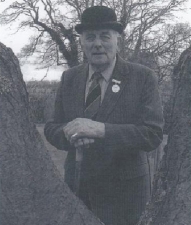
Mike has had a long association with shows in the area, firstly with the prestigious Ryedale event of the Malton Agricultural Society Show of which he has been both the Chairman and President, starting as the secretary of his first love the Show Pigeons which he has been breeding and showing since his youth. It was a job he held, along with the classes for rabbits and other furry animals for 45 years.
Mike was chairman of the show for 14 years, including the year when Malton had a royal visitor in "The Princess Royal". He went on to become President and is now a life member.
His involvement with agricultural shows has included 25 years as a steward of the Great Yorkshire Show, while his National and International interest in pigeons has seen him become chairman of the British Pigeon Show Society, and twice President of the National Pigeon Accociation. Mikes reputation as a pigeon expert has spread world wide, judging 20 times in the USA, as well as in South Africa, Israel and several European countries.
Throughout his life he has bred English Long Faced Tumbler pigeons - one of the oldest breeds in Britain and laterly Mike has introduced American show racers into his stud.
Today he has scaled down his numbers to 16 pairs because of his work as Maltons member on North Yorkshire County Council, of which he has been a member for 16 years and a past Chairman. He is also a member of Malton Town Council.
A keen sportsman, he has been President and Chairman of Malton and Norton Rugby Club and chaired the comittee which planned the relocation to its plush new ground and pavilion complex in Old Malton Road. He played fullback, initially in the forces while doing his National Service in the R.A.F and then for the Malton club.
On the future of Agricultural shows generally, he said " I believe they have a good future, but it is important that those such as Malton, Ryedale and Driffield, which are major farming areas, keep their farming role".
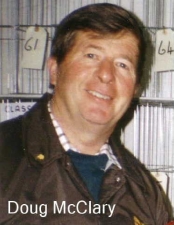
Show Racer Passion – How Lucky am I?
By
Doug McClary
In our lives we have to hope for good luck. Mine came when as a boy, a school friend took me to his dad’s farm, and showed me his pigeons. These were kept in a box secured to a wall and I watched in amazement as he liberated his birds – racers – and saw them fly about the place before trapping back into their ‘home’. I was hooked.
Up until that day I had kept all sorts of livestock, rabbits, guinea pigs, bantams and fowls in our largish garden in a remote Cornish village. From that time on however, I became a pigeon enthusiast and my other livestock, though still cherished, slipped down the order of things. Living nearby there was a pigeon fancier with Nuns who showed them regularly and my nearest neighbour exhibited his English rabbits. I was therefore attracted to the showing side of the hobby though I might just as easily at that stage gone in for racing pigeons.
However, soon after homing my first pigeons – obtained from nearby barns, my parents took me to the Redruth Agricultural show. For the first time I saw pigeons in exhibition but for me, the finest there were the beautiful show racers. Again, I was hooked and have been ever since – some six decades later. That is what I say about having luck in life, firstly to be introduced to pigeons, then to Show Racers in showing classes.
I became dedicated to owning my own show racers and fortunately for me, and I return to that factor of luck, I found that there was a thriving Penzance Fanciers’ Society where I received every possible help and encouragement. I also found that in and near the town there were a number of successful show racer fanciers who all provided that encouragement so necessary to provide a good start.
My mother and father were likewise extremely supportive. Carpentry has never been one of my skills but I made a show box out of wooden orange and apple boxes and painted it a bright green – the only paint available to me. Times were hard in the post-war conditions where food was scarce and under rationing. Tools were hard to come by also so it was with almost surprise that I completed my box. However, later on, answering an advertisement in Fur and Feather, I received a catalogue from Youngs of Misterton, Somerset in which they offered their own-made wicker show baskets for pigeons.
I persuaded my mother to allow me to ‘invest’ in a three-bird basket for which I had to use an easy payment system with my mother standing as guarantor. It was the only time in my life that I used ‘hire-purchase’ and I was able to pay it off by working in the area on farms and doing whatever else I could to earn a shilling or two. How proud I was of that basket and when I took my birds to the shows with it, I felt like a professional, though was of course still a raw novice. When taking my basket to the shows it was often doubled up, containing six birds, though when I sent it shows using the railways, the strict contents of three entries were sent.
To get to the shows I could occasionally get a bus into Penzance but often had to resort to walking there and back with my birds or on an old single-speed bike. Every show was exciting and eagerly anticipated. The parcels office at the Penzance railway station was the scene of some drama when the basket was opened when returned from shows, to check for prize cards. The local Penzance shows were good but we always knew that when farmer Brown of St Day came down, that we had less chances of winning because of the excellence of his stock. How I admired his powder blues and light mealies. It was my dream to be as good as him one day.
However, I had to leave home for work at the age of sixteen and eventually my little stud had to be sold. I was without pigeons for the years in which I lived as a single man in lodgings in various towns. Then came along my next lucky day, when I married Ann who not only tolerated my love for the pigeons but helped and encouraged me and in the ensuing fifty plus years has been my rock. She is as good a judge of the Show Racer as anyone else I know.
The luck still prevailed for we were offered a house with a flat garden and my thoughts were immediately directed to pigeons. I ordered a copy of ‘The Racing Pigeon’ weekly and when it arrived, there on the front cover was a photo of Mr Brown’s beautiful powder blue WF hen ‘Rosa Belle’ which had been best opposite sex at the Old Comrades show the previous week. I was captivated and wrote to the man who I would never have dared address when a boy. We corresponded and I bought a mealy cock and a powder blue WF hen from him. Eventually we became good friends and I visited the St Day lofts frequently to enjoy pigeon heaven amongst those beautiful show racers.
Those bloodlines are still with me and the love of the powder blue in particular. I can trace my present day birds down here in Australia back to the A.R.Brown birds, which in turn had come through C.R.Snow and Sam Arrowsmith. I have jealously guarded my lines and will always do so. Over the years a few crosses have been used but very few acquisitions have remained with me for very long because after use as a cross, they have been shipped out again. I believe that family line is the most important and enjoyable aspect of keeping my Show Racers.
The Show Racers have provided me with an all-absorbing interest, acting as a relief valve from the pressures of life and career, but also allowed me to make so many friends throughout the world. As a writer I have been able to meet some wonderful people both in the showing and the racing sides of the sport and hobby. My passion for the Show Racer is as strong today sixty years on, as it was in those heady days when I obtained my first birds and attended those first shows. I am pleased to acknowledge good luck and trust that it will remain with me to enable me to keep my birds for always.
Doug McClary is the author of the following titles, " The Showracer ", " Pigeon Showing " and " Pigeons for Everyone "
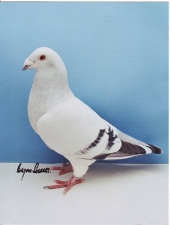
" Roly ", a real powder blue, my colour love.
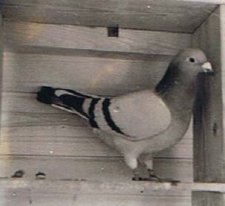
My original Blue W.F hen from Reg Brown. She had already won RES.BIS at the Welsh Charity and BOS at the Royal Dairy. For me she won 16 Firsts, many specials and other prizes. She last bred in 1973.
Doug McClary
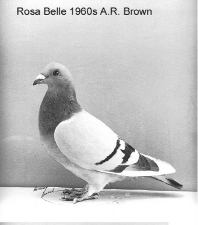
Rosa Belle, bred by A.R.Brown
DO WE LIKE CHANGE?
I have been enthralled by show pigeons for over 50 years and although my active involvement has had to reduce, my interest has remained strong. How have things changed over these years? For better? For worse?
It is easy to say that things used to be better back then and just as easy to say that those who make that statement are dinosaurs. Of course neither of these extremes is totally true.
Some of the biggest changes can be related to the way life and lifestyles change generally. Fifty years and more ago, we were picking up the pieces from the Second World War. Many people had allotments or smallholdings often born out of necessity to grow their own food and breed their own livestock. So many families were in this position that it was almost compulsory for children to grow up to be livestock orientated and so develop a very early interest in poultry, pigeons and others. This interest really stuck for many, like myself, who became lifelong fanciers.
Of course lifestyles have changed beyond recognition from those days and all this does have an impact on our hobby. Firstly, you are reading this because of computers/internet/technology. What an effect this has had on our lives. Television (also technology) is probably the single biggest change the world has seen. Sixty years ago only a minority of people had a TV set (only black and white and probably a 9” screen). BBC1 and BBC2 were the only channels. Now you can see world events as they happen on literally hundreds of channels. If you take a few moments to think about the impact TV and subsequent technology has had on the world, it is quite staggering. And all this in a relatively short period of time. Needless to say the counter attractions all these provide for our leisure time give small livestock hobbies some very serious competition. Sitting in front of computer/TV screens or looking after livestock in all kinds of weather – hardly a fair contest unless you are ultra keen.
To be able to keep pigeons ‘at home’ is also conditioned by regulations and covenants applied to properties, particularly newer housing estates. These are just a couple of the external factors which affect us – cost is obviously another important one. But what about specific changes within our fancy?
How many people recall that you could send birds to shows by rail! Or that classes usually had seven prize cards! Or that corn merchants would travel halfway across the country to deliver your corn to your door.
However in my experience the three major changes which have had a big impact during my time are as follows (not in any order of importance). Firstly, the introduction of individual membership of the NPA so allowing the payment of a membership fee and all that goes with it (voting rights, the facility to stand for election if you wish and to have an input into the national committee and influence the way our hobby is run). Many people do not avail themselves of these opportunities maybe because they have known no other system. Previously the average fancier had very little say in anything and was simply told how things would be. What is the saying about not appreciating what you have until it has gone?
Secondly, I see a massive reduction in what might loosely be called the social side of our hobby. This may well be linked to the disappearance of many two day shows. Whether you are for or against these longer events they certainly removed the big rush to get birds in, get them judged and get home (preferably by tea time). I have been amazed to see the signal to ‘basket your birds’ treated like the start of the London Marathon with everyone in a mad rush. There are certainly some downsides to a two day show but they provided time for much discussion and exchange of views between exhibitors, and with an earlier finish on the second day helped to solve the problem of long journeys to get home.
Maybe some of this is related to my third change which seems to be an ever decreasing desire for tough competition. The biggest single contributor to this was the rule change many years ago which removed the need for more than one exhibitor in a group of classes to qualify for NPA certificates which meant that you could not win by showing against yourself!!! – my goodness you can now. You can also multiply the number of classes (and still show against yourself). With more judges reluctant to withhold certificates, I wonder how many different pigeons some of our registered champions have actually beaten on the way through. I don’t know how many certificates are now available during a full show season but I have no doubt it is many times higher than it used to be and I guess it is still increasing year on year. Should we not want to compete against the best? I am sure our current successes at London 2012 could not have been achieved with an attitude of “Just let me win, never mind the level of the competition”. I could go on about this but I am now getting into the dinosaur territory.
I know that we need to encourage entries and support shows but we don’t have to offer the highest awards all the time, do we? Make them treasured, make them difficult to win, but maybe in an era where failure in school exams was referred to as ‘delayed success’ then winning anything is everything, or maybe it’s more a case of not wanting to take strength from losing sometimes.
However if these things bring people into this wonderful hobby then so be it. Attitudes, fashion and opinions change in every aspect of life including pigeons but let’s all remember to nurture our hobby, encourage newcomers and leave something for future generations to enjoy. We face enough external problems and we must work together for the good of everybody in the hobby.
I guess I had better get back to Jurassic Park now!
ALAN ROSCOE



